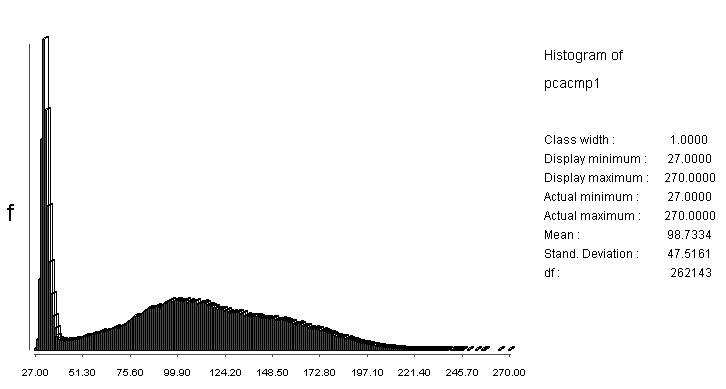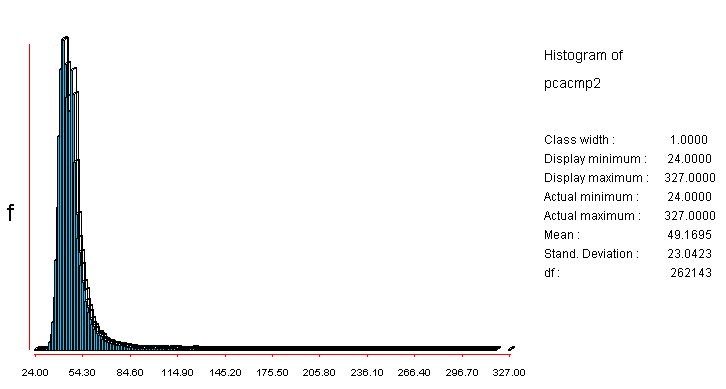

Principal Components Analysis is a procedure for transforming a set of correlated variables into a new set of uncorrelated variables. This transformation is a rotation of the original axes to new orientations that are orthogonal to each other and therefore there is no correlation between variables. The graph below shows a plot of band 2 versus band 1 of the Morro Bay TM scene. As you an see, the value of band 2 for a particular pixel is related to the value for band 1. The correlation is high.
Since the rotation is a linear combination of the original measurements, if all of the axes are included in the rotation, no information is lost. "No information is lost" means that the original measurements can be recovered from the principal components. If the original data set is singular, then principal components will produce a new representation that is not singular. There are several ways of viewing this transformation:
1. It can be viewed as a rotation of the existing axes to new positions
in the space defined by the original variables.
In this new rotation, there will be no correlation between the new variables
defined by the rotation. The first new variable contains the maximum amount
of variation, the second new variable contains the maximum amount of variation
unexplained by the first and orthogonal to the first, etc...
2. It can be viewed as finding a projection of the observations onto
orthogonal axes contained in the space defined by
the original variables. The criteria being that the first axis "contains"
the maximum amount of variation, or "accounts" for the maximum amount
of variation. The second axis contains the maximum amount of variation orthogonal
to the first. The third axis contains the maximum amount of variation orthogonal
to the first and second axis and so on until one has the last new axis which
is the last amount of variation left. As you can see these are really two slightly
different ways of saying the same thing!
There are several algorithms for calculating the Principal Components.
Given the same starting data they will produce the same results
with the one exception (are you surprised?). This exception is
that, if at some point, there are two or more possible rotations
that contain the same "maximum" variation, then which one is used
is indeterminate. In two dimensions the data cloud would look
like a circle, instead of an ellipse. In a circle, any rotation
would be equivalent. In an elliptical data cloud, the first component
would be parallel to the major axis of the ellipse.
To calculate the rotation we can start with either a Variance-covariance Matrix
or a Correlation Matrix. If one standardizes
the data and calculates a Variance-covariance Matrix, then the result will be
the same as a Correlation Matrix. Those that wish to practice their algebra
can prove this by deriving the formula for the Variance-covariance Matrix and
the Correlation Matrix calculated on "raw" data and then the Variance-covariance
Matrix calculated on standardized data.
The histogram of the first Principal Component for the Morro
Bay scene is:
The histogram for the second Principal Component of the Morro
Bay scene is:
Compare these with the histograms
of the original bands.
We can plot the second principal component versus the first
to get the 2D view that follows.
How do we get this figure? The elliptical cloud that lies parallel to the
X axis is what we might expect. But we need to remember is that we are carrying
out our rigid rotation of axes in a 7 dimensional space, one for each band (or
variable). We can see here that the original data was not Multivariate Normal,
an assumption that would need to be met if one wanted to carry out any parametric
statistical tests. This non-normality is indicated the anomalous cloud of points
going diagonally across the graph. If the data were multivariate normal in 7
dimensions, then the plot would only have a cloud like the horizontal one in
the above plot.
Collaborators: Code 935
NASA GSFC, GST, USAF
Academy Webmaster: Bill Dickinson Jr.



Primary Author: Nicholas M. Short, Sr.
email: nmshort@epix.net
Contributor Information
Last Updated: September '99
Site Curator: Nannette Fekete
Please direct any comments to rstweb@gst.com.